#Indo-Aryan Language
Text
Exploring the Richness of Sinhala: Sinhalese Language of Sri Lanka
Unveiling the Captivating World of the Sinhala Language
The Sinhalese language is a linguistic gem with deep roots in Sri Lanka’s vibrant culture and history. With its melodious tones and ancient origins, this Indo-Aryan language has fascinated linguists and culture enthusiasts alike. This article explores the fascinating intricacies of the Sinhala language, exploring its development, its…
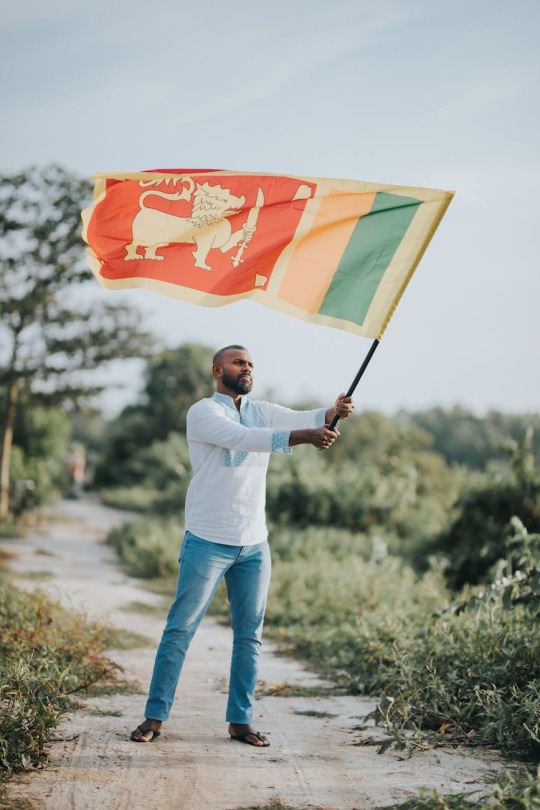
View On WordPress
#accessibility#Colloquial Sinhalese#Cultural Significance#Indo-Aryan Language#Language Access#Language Evolution#Language Services#Language Shift#LanguageXS#Linguistic Diversity#Literary Sinhala#Pali Influence#Sanskrit Influence#Sinhala Alphabet#Sinhala Interpretation#Sinhala Language#Sinhala Script#Sinhala Translation#Sinhalese Speakers#SOV Word Order#Sri Lanka Heritage#Sri Lankan Culture#Subject-Object-Verb#Syllabic Script#Vedda Language
0 notes
Text
The Inku Language
"Inku is an Indo-Aryan language spoken, at least historically, throughout Afghanistan by four of the country's nomadic communities: the Jalali, the Pikraj, the Shadibaz and the Vangawala.
Each of the four groups speaks a variety with slight differences compared to the others. According to their local tradition, their ancestors migrated in the 19th century from the Dera Ismail Khan and Dera Ghazi Khan regions of present-day Pakistan. Such an origin suggests that Inku may be related to the Saraiki language spoken there, though nothing is conclusively known.
The total population of the four Inku-speaking groups was estimated to be 7,000 as of the end of the 1970s. There is no reliable information about their present state, though it is unlikely that many have survived the subsequent upheavals in the country, and according to the entry in Ethnologue, which however may not necessarily refer to this language, the last speakers "probably survived into the 1990s".
Linguistic materials about the varieties spoken by the Shadibaz, Vangawala and Pikraj were collected by Aparna Rao in the 1970s, but they have not been published or analysed yet.
The following is an extract of a text narrated in 1978 by a man of the Chenarkhel subgroup of the Vangawala:
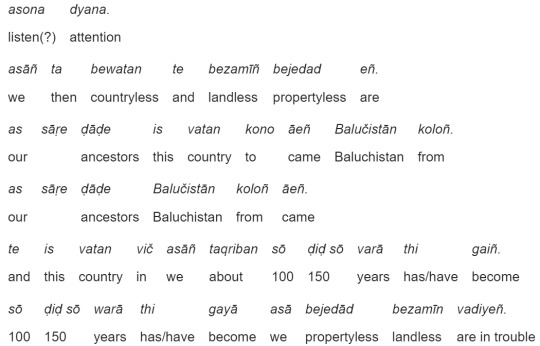
#the way i can understand most of this...#anyways this is all from wikipedia i havent had a chance to look at the references yet but there are a lot#i just couldnt contain my excitement at learning about a new language so i had to copy it all here for now#language#inku#afghanistan#indo aryan#dera ismail khan#saraiki#seraiki
5 notes
·
View notes
Text
Do you ever think about how we have completely bastardized what the terms “Caucasian” and “Aryan” are supposed to mean?
#Caucasian is from the region of Caucasia which is Georgia Azerbaijan and Armenia#aryan is the ancient indo iranians#language evolves whatever this is evolving in a bad way#unded rambles#language
7 notes
·
View notes
Text
Learning Telugu as a Maharashtrian be like;
Mi means "I or me" in Marathi while it means "you or your" in Telugu.
*gives up immediately*
#JK I'm determined to learn this damn language#Na Peru Sakshi#SEE I'm fucking fluent#😭😭😭😭#send help pls#Like aren't we supposed to be neighbours why are our languages so different!!????#(ik it's because Marathi is an Indo-Aryan lang while Telugu is Central-Dravidian)#But STILL
86 notes
·
View notes
Text
Iranians’ and Indian Muslims’ different relationships to European philology explain why the two conceived of their languages in such contrary ways. This divergence reveals the historical contingency of the two narratives. It was not inevitable that Iranian nationalism would adopt the philological model of linguistic continuity, which is made clear by comparison with Indian Muslims’ conception of Urdu as a mixed language.
This history leads to several conclusions.
First, what appears today as national culture – unique and discretely bounded – is the product of exchange with others from beyond the borders of the nation-state. This is certainly true of modern Iran. Nationalism, and what I call ‘Persianate modernity’, is the veneer that hides the very conditions of cosmopolitan cooperation and exchange that generated national culture in the first place. This suggests something about culture: it has no inherent politics, no predetermined trajectory.
Culture is an empty vessel that can be attached to all kinds of political projects. Cross-cultural exchange similarly can serve reactionary ends just as well as progressive ones. At the turn of the 20th century, exchange between Iranians and Indians served to alienate Indians from the history of Persian literature. More recently, the idea of Indian Muslims’ cosmopolitan origins has marked them as outsiders to India – a narrative adopted by India’s prime minister Narendra Modi and other Hindu nationalists to help marginalise and disenfranchise millions of Indian Muslims.
Nor is ‘indigeneity’ inherently progressive, a fact also illustrated by India’s Hindu nationalists. They now describe themselves as an indigenous population besieged by Muslim allochthones, ie foreign intruders. Indeed, we find the language of indigeneity taken up by ethno-nationalists elsewhere in the contemporary world – from the European Right, claiming to defend its indigenous culture against foreign refugees, to Jewish supremacists in Israel, who insist on their own indigenous roots in the land.
#persian#farsi#urdu#indo-iranian#indo-aryan#languages#asia#culture#south asia#west asia#islam#iran#india
12 notes
·
View notes
Text
"indian is such an ugly language" 1. not a language 2. you are a tar pit
#if u've ever heard like. any of the dravidian or indian indo-aryan languages. u wld know that is not true#fisher's lake!
2 notes
·
View notes
Text
The first letter change from 'a' to 'i' in the words Andra to Indra and Aryan to Iran is a common phenomenon in Indo-Iranian languages called "Satemization." Satemization refers to the shift in pronunciation of the Proto-Indo-European (PIE) velar consonants (/k/, /g/, and /gʰ/) to palatal or postalveolar sounds (/s/, /ʃ/, and /ʒ/) in the Indo-Iranian branch of the language family. This change occurred in the Indo-Iranian language branch around 1500 BCE, which led to the development of the satem languages (such as Sanskrit and Persian) from the earlier centum languages (such as Latin and Greek).
#satemization#linguistics#sanskrit#iranian#avestan#hindi#indo european languages#languages#indo iranian#indo aryan
3 notes
·
View notes
Photo
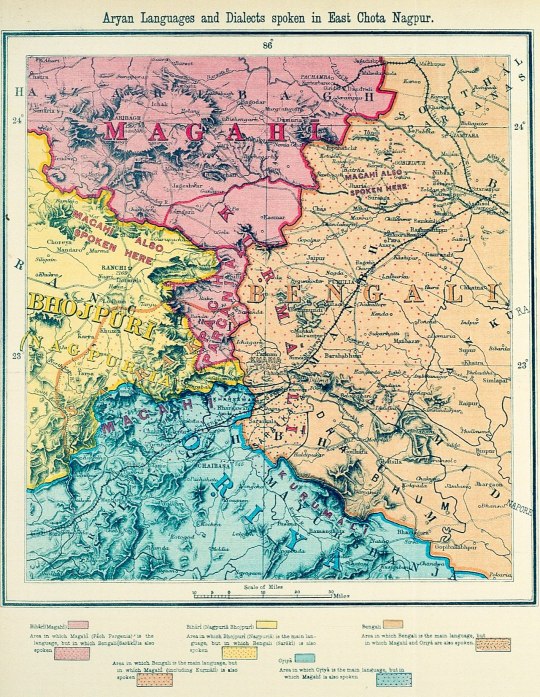
#indo aryan#magahi#magadhi#bhojpuri#hindustani#languages#map#history#linguistics#buddhism#bihar#bengal#chattisgarh#orissa#asoka#sramana#samana#meluhha#india#south asia
4 notes
·
View notes
Text
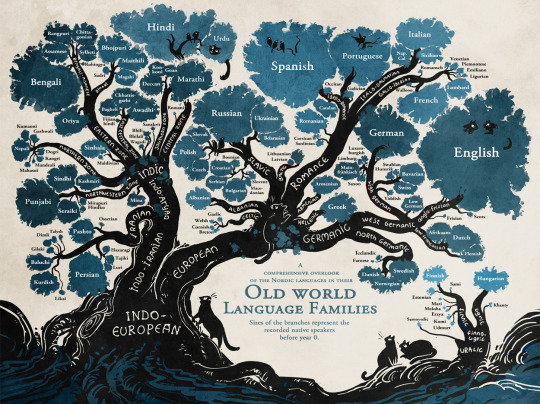
tumblr_nj03ev2YAk1qz6f9yo1_1280
1 note
·
View note
Text
I think as a society we need to remember Nazis are something specific.
Their ideology is largely the debunked theory that races have inherent qualities (and thus one could objectivly be superior), pan-germanism, and then blended with a bit of American white supremacists.
We know this. It's recorded.
"As the Nazi Party's chief racial theorist, Alfred Rosenberg oversaw the construction of a human racial "ladder" that justified Hitler's racial and ethnic policies. Rosenberg promoted the Nordic theory, which regarded Nordics as the "master race", superior to all others, including other Aryans (Indo-Europeans).[93] Rosenberg got the racial term Untermensch from the title of Klansman Lothrop Stoddard's 1922 book The Revolt Against Civilization: The Menace of the Under-man." Source.
The result was an ideology that uplifted Aryan Germans and persecuted others (like Jewish ppl) similarly to how American soldiers persecuted the natives.
It's merely a subset of white supremacy.
I think we as a society would do a lot better if y'all stopped calling every white supremacist a Nazi because while every Nazi is a white supremacist not every white supremacist is a Nazi.
There are subsets of it and each BIPOC people from every single country on this planet will tell you that white supremacy is there, it might just be a little different for each of us isn't that right? And your white supremacists think they're better than ours don't they; that they're better than Everyone else, aren't they? That their uniquely justified in hating everyone else, yeah?
Language does matter and as the court case goes on and people are really seeing both sides for the first time, we are seeing the very powerful relevance of language.
Let's not be a people that started calling Zionists and especially Jewish Zionists Nazis; not since it was specifically that brand of white supremacy that's responsible for the Holocaust. Zionism isn't Nazism. It's incorrect, antisemitic, and disgusting to say it is. I just didn't know how to articulate why before.
We can denounce white supremacy and white supremacists without being antisemitic. I think using language like that would be better for solidarity worldwide as well, anyway. To link our oppression this way rather than saying it Needs to look a specific way to be valid or count as bigotry to someone else.
The article linked for white supremacy says non-white people can and do believe it in it btw. This is no surprise for a lot of us but some of my haters audience might benefit from knowing that.
So familiarize yourself with it so that at the very least you don't keep saying ignorant things on the internet.
147 notes
·
View notes
Text
Badeshi: Only three people speak this 'extinct' language
By Zafar Syed, February 2018
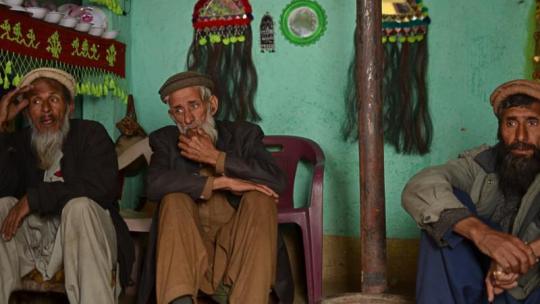
Would you like to learn a few words of a language only three people in the world speak?
Badeshi used to be spoken widely in a remote snow-clad valley, deep in the mountains of northern Pakistan.
But it is now considered extinct.
Ethnologue, which lists all of the world's languages, says it has had no known speakers for three or more generations.
But in the Bishigram Valley, we found three old men who can still speak in Badeshi (you can hear them in the video at the link).
"A generation ago, Badeshi was spoken in the entire village", says Rahim Gul. He doesn't know how old he is, but looks over 70.
"But then we brought women from other villages [for marriage] who spoke Torwali language. Their children spoke in their mother tongue, so our language started dying out."
Torwali is the dominant language in the area, which is itself under pressure from Pashto, but has pushed Badeshi to the brink in this valley.
"Now our children and their children speak Torwali," said Said Gul, Rahim Gul's first cousin. "So who should we speak our own language with?"
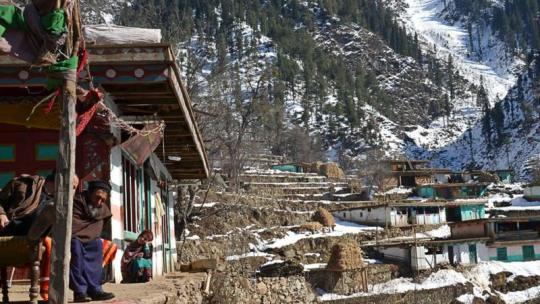
Said Gul also doesn't know his own age. When he said he was 40, somebody corrected him. "It's more like 80!" Said Gul quickly shot back, "No, may be 50, but not 80!"
There are no job opportunities in the area, so these men have spent a lot of time in touristy Swat District, where they have picked up the Pashto language, and that is mainly how they communicate.
Because of a lack of opportunities to use Badeshi, over the decades even these three men have started forgetting the language.
While they were talking in Badeshi, Rahim Gul and Said Gul regularly forgot a word or two, and could only remember after prodding from the others.
Rahim Gul has a son, who has five children of his own, but all of them speak Torwali.
"My mother was a Torwali speaker, so my parents didn't speak any Badeshi in the house. I didn't get a chance to pick it up in childhood. I know a few words, but don't know the language. All my children speak Torwali.
"I do regret it, but now that I'm 32 there is no chance I can learn Badeshi. I'm very sad at the prospect that this language will die out with my father."
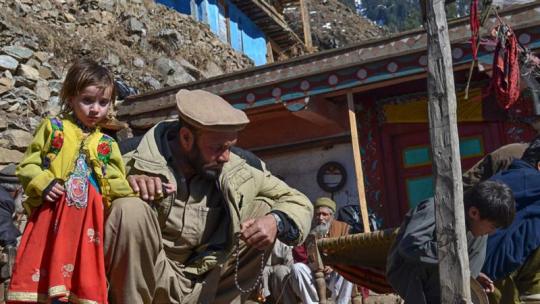
Sagar Zaman is a linguist affiliated with the Forum for Language Initiative, a non-governmental organisation dedicated to the promotion and preservation of endangered languages of Pakistan.
"I travelled to this valley three times, but the inhabitants were reluctant to speak this language in front of me," he says.
"Other linguists and I were able to collect a hundred or so words which suggested that this language belongs to Indo-Aryan sub family of languages."
Zaman Sagar says Torwali and Pashto speakers look down upon Badeshi, so there is a stigma attached to speaking it.
Perhaps it's too late to save Badeshi, but at the very least, you can learn a few words to keep the memory of the language alive:
Meen naao Rahim Gul thi - My name is Rahim Gul
Meen Badeshi jibe aasa - I speak Badeshi
Theen haal khale thi? - How do you do?
May grot khekti - I have eaten
Ishu kaale heem kam ikthi - There is not much snowfall this year
132 notes
·
View notes
Text
The Monkey King - Sun Wukong who first appears in Chinese stories (Journey to the West) during the Ming Dynasty period 1368 to 1644 CE, well after the introduction of Buddhism to China in about 206-220 CE.
But, was he inspired by another Monkey hero/character of myth?

The prevailing and dominant theory among Asian scholars is ...yeah, likely.
That character, Hanuman, king of the monkeys (the monkey people -Vanaras- of Vedic myth!).
The story follows a Buddhist monk who is accompanied by Sun Wukong and others to travel west to India to obtain sacred Buddhist sutras. Many of their powers and personality traits are similar as well.
We know that Vedic god such as Indra have made their way as far as Japan to take root and be worshipped because of the spread of Buddhism.
As I've talked about before and is shown in texts such as the journey's of Ibn Battuta / Ibn Fadlan, storytelling was a weapon and powerful tool for idea transfer--propagation. Philosophy was huge in the old world - and places such as Nalanda - the first residential university in the world - invited scholars from all over such as Greeks from the west, and the Japanese. Buddhism became a vehicle for trading things such as: martial arts information, medicine, sciences, and of course, myths and stories.
However, as with stories, people usually altered/coopted elements and molded them to better suit their cultures and fancy. That's a thing as old as time. I've shared how the panchatantra stories and jatka tales are thought to be the inspiration for nearly 30-50 percent of all nursery rhymes, ballads, "fairy tales".
Anyways back to this theory - Chinese Indologist Professor Liu Anwu of Peking University has dedicated chapters to the comparisons (in one of his works) to further break down this theory focusing on consistent and or similar depictions of beats in Journey to the West that of Rama's story in Ramayama and the Buddhist sutras.
Even though today the story of Sun Wukong is a wholly Chinese story - it's important to note the power of oral storytelling and how it travelled evolved over thousands of years, and, just as important, the vehicles it used to do so. Not just storytellers and philosophers and travelers but religion! Philosophy!
This is a theme heavily commented on and shown in Tales of Tremaine, which is my love letter and sort of self PhD. in comparative storytelling, mythology, and story foundry through an Asiatic lens (hence a silk road analog) stretching along a similar route the silk road did from damn near as far as you can east (complete with the oceanic routes) to as west as old venezia, portugal, and spain.
Also note: this is the most popular theory atm, but the operative word is theory. Experts likely far better than you, Internet, so chill before you comment, are still debating this. I know last week some of you were doctors in sociopolitical relations, the music industry before that, and then you were leading virologists before that. Spare us simpler folks from your mighty genius just now and sit down.
The point here is the beauty of stories and their ability to travel and morph and comment on themes/points ideologies important to cultures while being entertaining and showing that humans like certain universal moments, beats, archetypes, tropes, and progressions in tales.
Now, is that because we've naturally been predisposed liking them, or the opposite in that everyone went, yo, i dig this, took it home and someone else went, this is cool but needs to be more US (insert culture) and retold it. And thus...timemachine noises speed up. Here we are today?
You might not know that about 35,000 Chinese words ( I said this instead of Mandarin because they don't just show up in one language) are derived from Sanskrit as well as Pali (a Middle Indo-Aryan Liturgical Language -- meaning language of sacredness/religious use, in this case connected to sacred Buddhist texts). It is important to make the distinction, because, Internet!
Sanskrit did not SHAPE the Chinese languages. They evolved on their own. This is just a commentary on how words/stories shaped over travel in this case strongly through the spread of Buddhism.
Religion was the mover.
Back from quick bathroom break. Going to add again - INSPIRED is the keyword here.
INSPIRED.
Sun Wukong is his own mythos/character. Influence doesn't nor can claim dominion over everything in a later tale. Sun Wukong has gone on himself to inspire legends and characters Outside of China - re: most famously and legendary?
Son Goku - who is openly a Sun Wukong inspired character.
...hell, tbh, he might be the most famous monkey inspired super powered character now. Dude makes soccer stadiums air his fights. @_@.

#monkey king#monkey king journey to the west#hanuman#buddhist#buddhist monk#sun wukong#vedic gods#Japan#China#chinese legend#storytelling#mythology#myths and legends#asian mythology#mandarin#Sanskrit#pali#chinese language#dbz#dragon ball#dragon ball z#inspired#inspired by#the silk road#silk road retelling#philosophy#philosophers#journey to the west#fairy tales#nursery rhymes
26 notes
·
View notes
Text
Once in the course of a political project that involves killing and/or imprisoning >0 ppl you start getting very invested in language cladistics you have got to ask yrself, "Am i really about to sacrifice someones life and freedom in the name of a particular theory of the linguistic parentage of sanskrit/formosan/whatever?" It doesnt help the ppl arguing this shit are usually doing it about some crackpot theory where the nationalist tail is clearly wagging the historical linguistic dog but i think prolly 0 ppl deserve to die in the name of hindi being indo aryan either, like it just does not matter that much yk
31 notes
·
View notes
Text
Doctor Alto Clef Is Probably Not White
Dear SCP Foundation fandom, Doctor Alto Clef is unlikely to be white, or at least in the main canon and with his original author. The whole Francis backstory is frankly incredibly out of character and feels like a different character that his name was tacked onto for relevance and as a plot twist thing. Francis is generally incredibly well written, but Not At All The Same Guy.
In the main canon, IE the Clef-Kondraki incident, he is heavily implied to be THE BIBLICAL ADAM, in his interactions with the SCP who is clearly the Biblical Eve. She is canonically Middle Eastern, as are many Biblical figures both in the Bible itself and in the SCP canon. Clef converses with Eve in a language akin to Ancient Sumerian, fluently, and as if it is his first and most natural language. He also references Eden in other canon documents by the core Clef author.
PLEASE can we have more art of him as middle eastern! (You could make him lighter skinned going off of the one canon photo, you know, the one with the big ole rifle and his lovely DILF-esque tummy?) He's described as big-nosed and that's a feature that needs so much more love!!!
Often, in heterochromia, as he has, the brown or in his case "hazel" eye is the normal eye, with the blue one being the genetically mutated trait due to whatever condition causes said heterochromia, not to mention his condition likely being more anomalous than the usual genetic causes of heterochromia.
In terms of narrative symbolism, it makes the most sense for his third eye or aberrant secondary iris to be the green one, considering the color green being used in reference to reality benders and general symbolism in Western media as unnatural (when vivid), as magical and potentially villainous, and as ominous. (Think: Maleficent, Bruno Madrigal...etc)
Also! He is canonically fat and I am so so so sick of people erasing that about him. There is no excuse for that sort of erasure or for the 'inability' to draw larger bodies. His race is not explicitly stated in canon and is open to interpretation, however, due to his nature as heavily implied to be a pre-Christian biblical figure (Adam), I think it is most logical (as well as personally enjoyable for myself) to see him as Middle-Eastern Jewish (as opposed to Ashkenazic or Goy). He could easily be interpreted as North African, Middle Eastern, or even Central Asian, West Indian or Indo-Aryan, or an Ethiopian Jew.
#scp#scp fandom#scp foundation#scp fanart#scp shitposting#doctor clef#alto clef#dr clef#dr alto clef#scp doctors#scp dr clef#scp drama#scp dr kondraki
108 notes
·
View notes
Text
Ombra's Biography
Warning: mentions of trauma, death, mental health problems



The image on the left is made with X-girl maker and the one on the right is made in artbreeder.
General Information
Full Name: Atoosa Aryan
Name Meaning:
Atoosa - Daughter of the Cyrus the Great, bestowing very richly
Aryan - Relating to or denoting peoples speaking Indo-European (or specifically Indo-Iranian) languages
Nicknames/Alias:
Ombra - widely used by Metalrealmers and her allies
Boss - given by her comrades
My soul - given by Quan Chi
Age: 33
Date of Birth: November 26th
Zodiac Sign: Sagittarius
MBTI: INTP/INTJ
Sex: Female
Gender: Demigirl
Pronouns: She/They
Sexuality: Demisexual
Species: Half-human, Half-Metalrealmer
Race/Ethnicity: Iranian
Country of Origin: Iran
Current Place of Residence: Metalrealm
Physical Appearance
Skin: Normal. and smooth. Pale ivory.
Height: 5'10 / 178 cm
Weight: 149 lbs / 68 kg
Eye Color: Abnormal light gray
Hair Color: Dark brown
Hair Texture: Thick, almost curly
Body Type: Muscular, hour-glass figure
Prominent Features:
Square face shape
Iron-jaw
Thick eyebrows
Broad Shoulders
Clothing Style: Ombra’s default outfit includes a black overcoat with a black vest which is secretly bulletproof, black pants and bottom-up shirt underneath the coat, and knee-high punk boots. These items can vary in their gothic and steampunk elements. In general, she prefers her outfits to be gender neutral.
Personality
Positive Traits: Mature, intelligent, understanding, patient, confident, logical, calculating
Negative Traits/Flaws: withdrawn, stoic, bloodthirsty, vengeful, gloomy, impious, stubborn, controlling, easily annoyed, remorseless, radical
Hobbies: playing chess, reading, traveling
Likes: playing chess, solving mysteries, studying, traveling
Dislikes: 98% of the people, dancing, singing, children
Goals: destroying the Cult of The Elder Gods, solving Falkus’s mystery
Fears: losing her political position and power in Metalrealm, losing Quan Chi
Health
Physical Health: Ombra has had an eye surgery as she used to be short-sighted. A few years ago, her jaw was severely broken, so instead of fixing it she replaced it with an iron one.
Mental Health: Ombra embodies symptoms of OCD, depression and ADHD. Due to her past trauma she gradually became murderous and bloodthirsty. Almost everyone is stupid in her view, so that’s another reason, beside being an introvert, why social interactions are usually intolerable for her. Since she was contanstly under control from both her parents and the society in her past, she eventually became a controlling adult. Ombra was born and raised among religious people and in a society ruled by religious beliefs, so the traumas turned her into an impious person who thinks religious people are stupid and close-minded.
Phobias: Thalassophobia
Professional Life
Education: Ombra was close to earning her Ph.D in psychology when she left to live in Metalrealm.
Professions: The president of the Interrealm Forces in the MRD Organization
Fighting Attributes
Abilities/Powers:
Ferrokinesis - Ombra has the ability to manipulate anything of iron or has iron in it. This includes distorting the shape of those materials, and creating iron out of thin air.
Heat and electricity manipulation (very limited) - iron is a heat and electricity conductor, so if Ombra turns her limbs into iron, she can manipulate them to her advantage.
Sound manipulation (very limited) - sound can travel through iron, so Ombra can sometimes make a use of it.
Blood manipulation (very limited) - due to iron existing in blood she can manipulate it to her advantage.
Skills:
Using melee weapons
Using rifles
Martial arts and self defense
Strengths:
Close-combat
Negotiable
Weaknesses:
Ranged-combat
High electricity pressure
Extreme heat
Strong soundwaves
Magnets
Weapons:
Melee weapons she created with her power
A gunblade
Relationships
Family:
Unknown father - deceased
Unknown mother - deceased
Older sibling: Gizem - alive
Friends/Allies:
Quan Chi
Gizem
Shinnok
Kano
Erron Black
Kabal
Noob Saibot
Havik
Shao Kahn
Menace @bisexualjohnnycage
Andrius Nils @scentedcandleibex
Sienna @loverofthewindgod
Zoe @zoetheneko
Dia @darialovesstuff
Enemies:
The Elder Gods
Hanzo Hasashi
Varian Hasashi @middlechildwhoescapedthebasement
Kuai Liang
Jax Briggs
Jacqui Briggs
Nightwolf
Kotal Kahn
Love Interest:
Quan Chi - lovers
Alternate Universe:
Lady Xuna @bisexualjohnnycage
Huepazu @huepazu
Valerie “Gorgon” Watson @poisonedtruth
Leila @takiisieju-moved
Alex Demir @chadillacboseman
Backstory
Centuries ago, Delia had a vision about a woman dressed in all black outfit who was slaying the cultists one by one, threatening the Elder Gods themselves. She couldn’t discover her name, but one thing was certain about her: she was a half-Metalrealmer.
Atoosa Aryan was born in Hamedan, Iran among religious people whose lives were ruled by a religion centered society. Atoosa's family was considerably functional. She was a gifted kid who gradually became a perfectionist, and also a people pleaser thanks to her controlling mother who cared a lot about what others were thinking about them. Atoosa's powers were revealed when she was a toddler. Her powers were extremely weak, yet her mom constantly warned her to conceal it.
Atoosa used to be a cheerful and quite energetic child, but growing up in an extremely male dominant country which was also torturing its people with poverty and increasing number of crimes, turned her into a reserved and stoic adolescent with a pretty low self-confidence.
In order to escape, save herself and create an ideal life Atoosa emigrated to Turkey. She studied psychiatry in university. She was one year away from graduation and earning her PhD when her parents decided to pay her and her older sibling, Gizem, a visit. But the airplane was targeted by two rockets. Atoosa swore to find and punish anyone who was behind that incident.
Meanwhile, without her knowing anything, Metalrealmers were searching the universe for that certain half-metalrealmer to kill her. Metalrealmers believed that their gene must not become impure as they wanted to preserve their magic. Raiden was also aware of this, so he also began to search -as his duty to preserve the cult- only to find out that she lives in Earthrealm, and as its protector it was easier for him to uncover her identity. Raiden saw a great potential in her, yet he was quite afraid of her and what she could turn into, so he decided to offer her a place in the Sky Temple. He wanted to keep a close eye on her and make sure that she never gets the chance to gain power and become that monster in Delia’s prediction.
Eventually, Atoosa reluctantly trusted him only because she needed some help in order to survive. She moved to the Sky Temple, and began her job as a maid. She was miserable. She barely had time to focus on her studies and dreams.
A complicated relationship was formed between Raiden and her. Atoosa needed him, yet she was mad at him for putting her in so much misery. On the other hand, Raiden didn’t want to see her suffer, but he had no other choice.
Atoosa’s depression got worse, and suicidal thoughts began to lurk in the back of her mind.
Then Falkus came to action. He knew about Atoosa, and had discovered her location. He wanted to use her as an intelligent weapon to destroy the cult, and gain his freedom. He made contact with Atoosa, and tried to talk to her, and technically, brainwash her to believe in what he believed. He wanted her to escape Raiden on her own. Falkus told Atoosa about the cult, and that her parents’ death was their fault. He reassured her that if she came with him, he’d protect her from Metalrealmers and give her all she needs to take her revenge.
Atoosa didn’t want to trust anyone ever again, but she had nothing left to lose after all, so she only pretended that she trusts him, and moved to Metalrealm. She had other things in her mind. She must be the one in control this time.
She started her training in the MRDO, and focused more on her psychology studies. Without Falkus’s knowledge, she took every opportunity to earn a higher place in this organization. She helped the chiefs and soldiers in numerous missions by her strategic mind and great knowledge in psychology. Eventually, she achieved her goal, and also gained the nickname that almost replacedher real name: “Ombra the Ironhead”.
Ombra became the chief of the Interrealm Forces. She arranging her own plan for the revenge on the cult. She wasn’t under anyone’s control as she desired. She told Falkus that she was merely his ally, not a servant or a weapon.
Now Ombra wants to unleach her wrath, and destroy those who took away her innocence, childhood and dreams.
#mortal kombat#mk#mk oc#mortal kombat oc#ombra the ironhead#quan chi#shinnok#havik#gizem#kano#erron black#kabal#noob saibot#shao kahn#hanzo hasashi#kuai liang#jax briggs#jacqui briggs#nightwolf#kotal kahn#raiden
78 notes
·
View notes
Text
a few notes on studying pre-christian slavic religion:
anything ever written about slavic polytheism by v. ivanov and v. toponov is wrong. these people would claim bacchus to be a hypostasis of the buddha if they could. in general i'd say russian scholarship on slavic polytheism is quite poor, on account of the flourishing of rodnovery and similar pagan revival movements in the country—a bummer, bc the rus' are one of the two main sources on pre-christian slavic religion we have. the 'purest' records of slavic paganism we have come from where it was forgotten, where theonyms were relegated to toponymy and pre-christian rituals survived only in half-remembered folk proverbs; where neopaganism and romantic nationalism touched pre-christian slavic polytheism, they mutilated it (sometimes irreparably)
the other main source we have are the accounts of the rites and beliefs of polabian slavs—a bummer, bc the polabians appear to had practiced a deeply divergent form of slavic religion. the (taboo?) replacement of more-or-less all theonyms with honorifics and euphemisms is particularly exasperating. i imagine this was partially due to their placement at the western edge of the slavic world, and partially due to the effects of their resistance against germanic settler colonialism and christian proselytisation on polabian society and ritual
the relationship of slavic religion with that of the indo-iranian peoples is. complicated. the contact between the two was quite intense and very long, and the influence of iranic peoples (through the scythians, in particular) on early slavic society was immense. reconstructing what slavic religion looked like before iranisation is impossible, though baltic folklore might prove helpful as a point of comparison. well, unless balto-slavic and indo-iranian do in fact constitute a single clade within the indo-european family—in which case the similarities between the two might as well be ascribed to recent common descent
on the topic of (indo-)iranians—the question of a zoroastrian substrate in pre-christian slavic religion remains open! the main point of debate is the etymology of proto-slavic *divë, 'giant; demon'. descendants of the reconstructed form appear to be mostly restricted to south slavic languages, which might point to the word being borrowed from (the systematically persianised ottoman redaction of) turkish. even if the word was borrowed from proto-iranic *daywáh (whence daeva, 'demon'), iranic influence on the slavs goes way, way back before zoroaster's reforms; attempts to outright extrapolate slavic cosmology from zoroastrianism are bunk. there is no evidence of dualism in pre-christian slavic religion
so! basically: if you must compare slavic religion with other indo-european faiths, compare it with baltic religion first; iranian (scythian, etc.) religion second; indo-aryan (vedic) religion third; and germanic + finnic religions fourth, if only to sieve out the possibility of borrowings. the kievan rus' appear to have directly borrowed some deities from the iranians (like khors), without even modifying their names or bothering with interpretatio slavica—i pray the origin of other borrowed deities is just as transparent
#i'm ordinarily not this utterly preoccupied w slavic paganism#but this is the first time i've ever devoted serious attention to the subject despite being mildly interested in it for years#vampire poasting shall resume shortly
19 notes
·
View notes